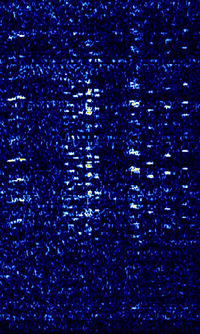ISCAT
Ionospheric Scattering (ISCAT) mode used for weak signal long distance radio contact by meteor and Ionosphere scattering.
ISCAT has two sub-modes: ISCAT-B and ISCAT-A. ISCAT-B is the original ISCAT mode with total bandwidth 1809 HzHertz (Hz), unit of frequency, defined as one cycle per second (1 Hz).. ISCAT-A runs at half the rate, uses half the bandwidth, and (for average decodes on steady signals) is about 1 dBThe decibel (dB) is a logarithmic unit used to express the ratio of two values of a physical quantity, here the strength of a received signal. more sensitive.
Samples[edit]
| ISCAT-A (Sim) | ISCAT-A Signal |
|---|---|
| ISCAT-B (Sim) | ISCAT-B Signal |
|---|---|
Frequencies[edit]
ISCAT is generally used on the 2-meter (144 MHzMegaHertz (MHz) 10^6 Hz - 148 MHzMegaHertz (MHz) 10^6 Hz) and 6-meter (50 MHzMegaHertz (MHz) 10^6 Hz - 54 MHzMegaHertz (MHz) 10^6 Hz) amateur bands, such as 50.248 MHzMegaHertz (MHz) 10^6 Hz
Video Examples[edit]
Decoding Software[edit]
- Hobby Level Software




